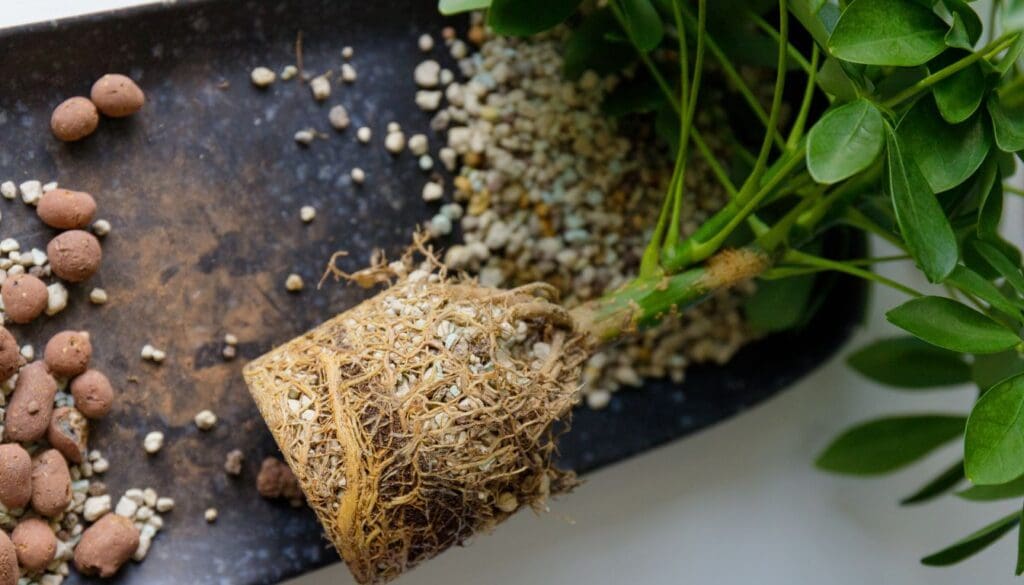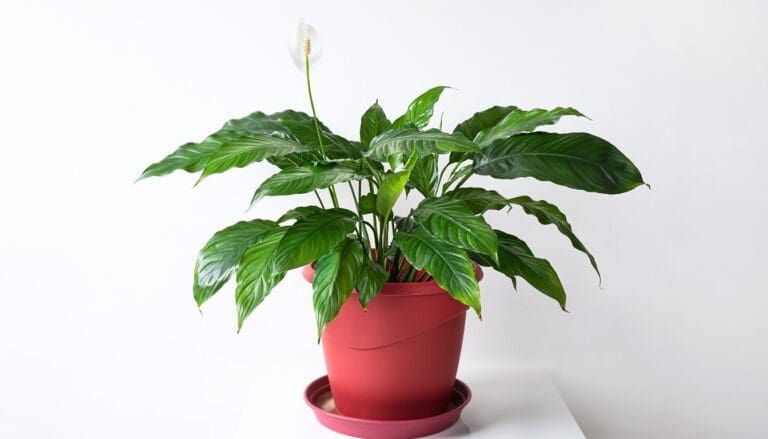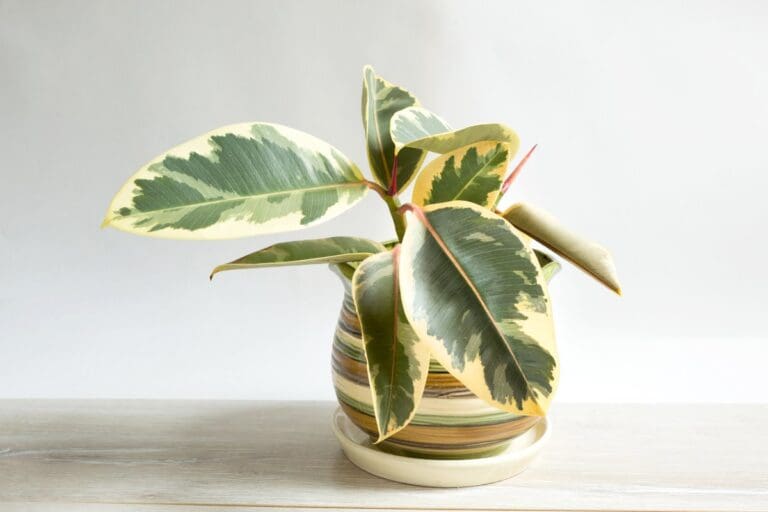How To Prune A Schefflera Plant? (A Step-by-Step Guide)
Schefflera or umbrella plants are gorgeous tropical plants grown as houseplants for their evergreen umbrella-shaped foliage. Though a low-maintenance plant, pruning is one of the essential practices necessary for the plant’s healthy growth.
To prune the Schefflera plant:
- Take a sharp and sterilized pruner.
- Inspect the plant thoroughly to find the areas that need pruning.
- Cut right above the leaves and trim the top of the tallest stems to encourage more growth.
- Don’t forget to prune the dead and damaged foliage and stems.
- Provide proper growing conditions after pruning the plant.
Remember, if you prune the plant incorrectly or at the wrong time, it can harm its health.
In this article, I will talk about the signs that tell your Schefflera requires pruning, the benefits of pruning, the correct time of pruning, and a thorough guide on how to prune the umbrella plant.

Please note: Simplify Plants is reader-supported. Some links in the post are affiliate links and I get a commission from purchases made through links in the post.
Signs that show your Schefflera needs pruning
Before we discuss the pruning of your Schefflera, we must learn to identify the signs that the plant shows to tell us that it requires pruning.
Discolored foliage
Yellow, brown, and dry leaves are either signs of internal problems like incorrect watering, transplant shock, temperature fluctuations, etc., or the plant’s natural aging.
These leaves need to be pruned off because they cannot go back to their green color, so keeping them attached to the plant only wastes its energy.
So it is best to reduce the necessary stress on the plant by trimming them off.
Leggy growth
When your Schefflera grows for a long time without pruning, the plant’s body tends to become leggy and thin, losing its robustness.
The plant appears to lose its appeal by becoming narrow and less bushy.
This is a sign by your plant that it is time that you need to trim off the parts to make them grow fuller again.
Trimming these parts helps the plant to focus on healthy and fuller growth.
Root rot

Root rot is a disease that results from overwatering.
When the soil stays soggy for a long time, the roots begin to suffocate due to a lack of oxygen.
This creates a rotting condition, causing pathogens and fungus to attack the roots.
The rotting spreads quickly to all the roots and, if not treated, can kill it.
There might be root rot if you notice the soil staying soggy for a long time and the leaves appearing droopy and pale or smell coming from the soil.
In such cases, it is best to take the plant out and trim all the decayed roots and repot it in fresh soil to save it from dying.
Stunted growth
Your umbrella plant’s growth reduces in the winters due to its dormancy, but during the other times of the year, the plant grows well.
So if you happen to notice that the plant has reduced growing although it’s the growing season, then that might indicate that the plant requires pruning.
Pruning helps the plant push out more growth and get denser when its growth stops.
Pest infestation

When your plant gets infested by pests, pruning becomes important.
If you notice bugs have infested certain parts of the plant, you should prune off those parts immediately without delay and spray Neem oil on the plant.
This would keep your plant healthy.
Also read: Schefflera Pest Problems: Common Pests & Diseases+How To Fix
Benefits of pruning your Schefflera plant
Pruning helps the Schefflera in multiple ways, so it is recommended for plants.
Let us learn about some of the benefits.
- It improves the visual beauty of your plant.
- Pruning makes the plant look fuller and bushy.
- Trimming the stems releases growth hormones that encourage the plant to grow more side stems. It boosts the plant to push out newer growth and foliage.
- The plant gets more energy and nutrients after pruning. This is because they spend a lot of energy attaching the dead and unnecessary parts of the plant to them. Once they get rid of those parts, they use that energy and nutrients for more new growth.
- Pruning the plant’s pest-infested and diseased parts helps keep the plant healthy.
- Pruning prevents leggy growth, which mostly happens due to the plant not getting sufficient light, so trimming those plants makes the plant even.
- Keep the Schefflera in good shape as pruning helps prevent excessive overcrowded plant growth.
- Pruning the decayed roots of Schefflera that have become mushy and brown helps prevent infection from spreading and helps the plant come back to health.
When should Schefflera be pruned?
You must remember that pruning stresses the plant, so you should do it during the growing period when the plant is strong and fuller so that the plant finds it easy to overcome that shock.
You can remove the dead parts of the plant any time of the year, but when it comes to extensive pruning, correct timing is important.
The best time to prune a Schefflera is in spring and early summer, around February to March, when the temperatures are favorable.
Do not prune your plant when the weather is too hot or too cold.
This can shock the plant, and it may face difficulty overcoming the stress.
Tools required for pruning Schefflera

Before you start pruning, make sure you have all the necessary equipment near your hand so that you do not have to search for them mid-way.
- Sterilized sharp pruning shears: Keep a sharp, clean pair of pruning shears ready, and do not forget to sterilize them before and after use to prevent the spread of germs.
- Gloves: Schefflera plants contain calcium oxalate crystals in their sap which is very harmful. If the sap touches your skin, it can lead to infections, rashes, and itching. So to protect your skin wear a pair of gloves before you start pruning.
- Disinfectant: You must always disinfect the pruners to prevent fungus from spreading.
- A pot and potting mix: If you wish to propagate the pruned parts of your plant or you need to plant the cutting in fresh soil, keep a new pot and potting mix ready.
How to prune the Schefflera plant?
Now let’s discuss how you should start with the main work.
Though many plant growers believe it to be a tricky job, it is not really.
If you have the correct knowledge and follow the right procedure, pruning is easy.
1. Examine the Schefflera thoroughly

The first and foremost step is to examine the entire plant thoroughly.
Notice all the minute areas: the leaf structures, the stems, the nodes, and also if there are any pest infestations in any area.
Do not begin pruning without first examining the plant.
2. Identify the areas that you need to prune
Identify the areas that require pruning.
Otherwise, you may prune the parts that you should not have pruned.
Find areas where the leaves and stem have become dull, discolored, or leggy.
3. Prepare for pruning
Once you have a clear idea of the areas you need to prune, it is time to get ready.
Do not forget to wear your gloves to protect your skin from the toxic sap of the Schefflera.
Also, remember to disinfect the pruning shears.
4. Get to pruning

Now with the clean shears, start pruning your plant.
Begin by cutting off dead leaves and dried-out branches.
You can do this any time of the year as this light pruning will stress the plant.
Always prune above the growth nodes from which the leaves come out.
This will encourage new growth that will make the plant bushy.
You can also prune the leggy and crowded parts you will notice if you haven’t pruned your umbrella plant for long.
While pruning the leggy stem, you can cut back up to 6 inches.
5. Dispose of the unhealthy parts
After removing the diseased and dead parts of the plant, discard them immediately and do not let them come in contact with the other plants, which might lead the fungus to spread to other plants.
6. Use the healthy cuttings for propagation

If you want to use the cuttings to propagate new plants, you must choose some healthy stems and grow them in water or soil to get more plants.
Aftercare
After pruning, you should give the plant the correct growing conditions to flourish.
This helps the plant overcome the stress of pruning and makes it bounce back faster.
Let us quickly go through the care of the Schefflera post pruning.
| Factor | Care tips |
|---|---|
| Light | Place the plant at a spot where it receives bright but indirect sunlight. Do not place it in a low light condition or in direct scorching sunlight. |
| Water | Water the plant when the topsoil gets dry. Do not overwater as these plants are prone to overwatering and root rot. |
| Soil | Grow the plant in soil that is loose and well-draining while it also retains some moisture. Add sand, perlite, and peat moss to the soil to make it light. |
| Humidity | Provide the Schefflera with at least 50% humidity. Install a humidifier or pebble trays if your home has dry air. |
| Prevent leggy growth | Leggy growth of the plant occurs due to low light conditions. When the plant does not get sufficient light, it starts to tilt and grow in the direction of the light. So rotate the plant weekly so that all the sides get even light. |
| Fertilizer | These plants are not heavy feeders, so feed them only in the growing season with a balanced fertilizer of NPK 20-20-20 or a handful of compost. Do not fertilize the Schefflera in the winters, as that may lead to root burn. |
| Temperature | Umbrella plants thrive at temperatures between 65-90°F. Be careful not to expose this plant to extreme cold and frost. |
| Placement | Keep the Schefflera at a place where it gets bright but indirect light. Do not keep them near glass panes where the leaves may get rubbed against the glass. Also, do not place them near AC vents or heaters, which would dry the plant. |
| Repotting | The best time to repot your Schefflera is the growing season which is the spring and early summers. Do not report in harsh summers or during winters. |
How to propagate a Schefflera cutting?

You can propagate Schefflera cuttings both in soil and water.
You have to get a fresh stem cutting and ensure it does not have any disease or fungus growth.
Do not take a stem that is not fully developed and only propagate mature stems.
Since you can propagate them both in water and soil, you can choose any convenient method.
- For soil propagation, you can take a small pot and mix sand and peat moss to grow the cuttings.
- Now take the cutting and apply some rooting powder at the end. Though it is optional, it helps to root the cuttings faster.
- Now plant the cutting in the soil, water it evenly, and cover the pot with a plastic bag to lock the moisture inside. Cuttings need a lot of moisture to root, so when you cover them with a plastic bag, they get a greenhouse effect which helps to keep the moisture intact.
- After a week or so, remove the plastic bag and check the soil. If you find the soil dry, just spray some water to make it moist and cover it again.
- Keep the pot in an area that receives bright indirect light.
- Roots should start appearing after 4-5 weeks.
- Wait until the roots get bigger and stronger before repotting them in fresh soil.
If you wish to propagate it in water, then fill a glass with distilled water for propagation.
Dip the cutting and keep it in a space that receives bright indirect light.
In water propagation, you can check the progress of the roots easily, so once you see the roots growing bigger, you can shift the cutting to the soil.
Final words

Pruning is an important part of the Schefflera care routine, which plant growers often ignore. Your houseplants need to be pruned for multiple reasons, including good growth.
Remember not to prune the plant in winter as that might lead to stress, which can get difficult to overcome due to their dormancy. Prune your umbrella plant only in the growing season, which would help the plant push out more growth.
You can prune the dead and damaged parts any time of the year as these will reduce the stress off the plant. After pruning, provide the right growing conditions so your Schefflera can produce healthy and fast growth.
Reference: Wikipedia, Sciencedirect, Britannica, American Society for Horticultural Science, Schefflera taxonomic history.
Recommended Garden Supplies
| Product Image | Our Recommended Gardening Supplies | Check Offers! |
|---|---|---|
Top Top
Top
Top
Top
Top
Top
Top
Top | rePotme Houseplant and Tropical Classic Potting Soil Mix | Check Offer On Amazon |
 Top
Top
Top
Top
Top
Top
Top
Top | Espoma Organic Indoor Plant Food | Check Offer On Amazon |
 Top
Top
Top
Top
Top
Top
Top
Top | GooingTop LED Grow Light 6000K Full Spectrum Clip Plant Growing Lamp | Check Offer On Amazon |
 Top
Top
Top
Top
Top
Top
Top
Top | Soil Moisture Meter | Check Offer On Amazon |
 Top
Top
Top
Top
Top
Top
Top
Top | Govee Hygrometer Thermometer, Bluetooth Enabled! | Check Offer On Amazon |
 Top
Top | LEVOIT Humidifiers for Large Room(Best For Plants) | Check Offer On Amazon |
 Top
Top
Top
Top
Top
Top
Top
Top | Upgraded DIY Automatic Drip Irrigation Kit, 15 Potted Houseplants Support | Check Offer On Amazon |
 Top
Top
Top
Top
Top
Top
Top
Top | Stainless Steel Heavy Duty Gardening Tool Set | Check Offer On Amazon |
 Top
Top
Top
Top
Top
Top
Top
Top | Bonide Insecticidal Soap | Check Offer On Amazon |
 Top
Top
Top
Top
Top
Top
Top
Top | Bonide 32 oz Spray Neem Oil for Organic Gardening | Check Offer On Amazon |
 Top
Top
Top
Top
Top
Top
Top
Top | Garden Safe Fungicide | Check Offer On Amazon |







Great information. It would be nice to see an actual example of pruning a Schefflera.